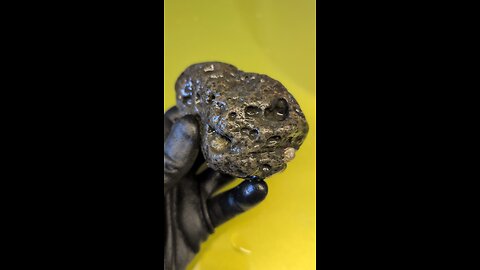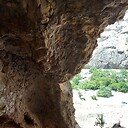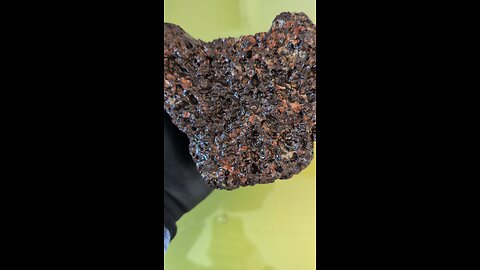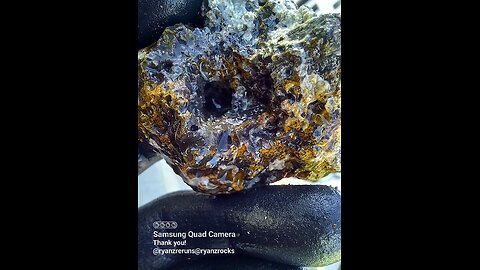
Lava Rock!
4 videos
Updated 7 months ago
Magma is less dense than the surrounding rock which causes it to rise. When magma reaches the surface it is then called lava and the eruptions of lava and ash produce volcanoes. The lava that reaches the Earth's surface will harden and become igneous rock.
Igneous rocks solidify from molten rock (called magma within the Earth and lava on the surface). They are identified by mineral content and texture — the size and shape of their mineral grains.
-
Basalt Lavarock!
 HumbleConservativeBased on the appearance of the rock in the image, it looks like it could be a type of volcanic rock, specifically scoria or vesicular basalt. The rock has a porous texture with numerous small holes, which is characteristic of scoria, formed when gases trapped in the molten lava escape during an eruption, leaving behind bubbles. The dark coloration and rough surface also support this identification.46 views
HumbleConservativeBased on the appearance of the rock in the image, it looks like it could be a type of volcanic rock, specifically scoria or vesicular basalt. The rock has a porous texture with numerous small holes, which is characteristic of scoria, formed when gases trapped in the molten lava escape during an eruption, leaving behind bubbles. The dark coloration and rough surface also support this identification.46 views -
Big Daddy!
 HumbleConservativeScoria is a type of volcanic rock that forms from the rapid cooling of lava rich in gas. Here's a detailed explanation: Formation: Scoria is typically formed during volcanic eruptions when dissolved gases in the magma come out of solution as the pressure decreases, creating bubbles in the lava. When this gas-charged lava is ejected and cools quickly, it solidifies with these bubbles trapped inside, resulting in a porous texture. Characteristics: Texture: Scoria has a vesicular texture, meaning it is full of small cavities or vesicles, which are the remnants of gas bubbles. These vesicles can give scoria a lightweight, pumice-like appearance, though scoria is generally denser than pumice. Color: It is usually dark in color, ranging from black to dark brown or reddish-brown, due to its high iron and magnesium content. Composition: Scoria is primarily basaltic or andesitic in composition, containing minerals like plagioclase, pyroxene, and olivine. Uses: Scoria is used in construction for lightweight concrete,39 views
HumbleConservativeScoria is a type of volcanic rock that forms from the rapid cooling of lava rich in gas. Here's a detailed explanation: Formation: Scoria is typically formed during volcanic eruptions when dissolved gases in the magma come out of solution as the pressure decreases, creating bubbles in the lava. When this gas-charged lava is ejected and cools quickly, it solidifies with these bubbles trapped inside, resulting in a porous texture. Characteristics: Texture: Scoria has a vesicular texture, meaning it is full of small cavities or vesicles, which are the remnants of gas bubbles. These vesicles can give scoria a lightweight, pumice-like appearance, though scoria is generally denser than pumice. Color: It is usually dark in color, ranging from black to dark brown or reddish-brown, due to its high iron and magnesium content. Composition: Scoria is primarily basaltic or andesitic in composition, containing minerals like plagioclase, pyroxene, and olivine. Uses: Scoria is used in construction for lightweight concrete,39 views -
Lavarock!
 HumbleConservativeLava rock, often referred to simply as "lava," is a term commonly used to describe various types of igneous rocks that form from the cooling and solidification of molten lava on the Earth's surface. Here are some key details about lava rock: Formation: Lava rock forms when magma, which is molten rock beneath the Earth's surface, erupts as lava during a volcanic eruption. Once exposed to the cooler temperatures at the surface, the lava cools and solidifies into rock. Types of Lava Rock: Basalt: The most common type of lava rock, formed from low-viscosity, mafic lava. It's dark, fine-grained, and can have a vesicular (full of small holes) texture if gas escapes during cooling. Andesite: Intermediate in composition, often found in subduction zones. It's lighter in color than basalt and can have a porphyritic texture. Rhyolite: Formed from high-viscosity, felsic lava, typically light in color with a fine-grained or glassy texture. It often forms during explosive eruptions. Pumice: A very light, porous form of lava rock with a high gas content, which can float on water due to its low density. Obsidian: A volcanic glass that forms when lava cools very rapidly, preventing crystal growth. It's usually black but can have other colors due to impurities. Texture: The texture of lava rock varies widely: Aphanitic: Fine-grained, where individual crystals are not visible to the naked eye due to rapid cooling. Vesicular: Contains gas bubbles or vesicles, common in basalts and pumice. Glassy: Like obsidian, where the rapid cooling prevents crystal formation. Porphyritic: Contains larger crystals (phenocrysts) within a finer matrix, indicating a two-stage cooling process. Color: The color can range from black or dark gray (basalt, obsidian) to light gray, pink, or even white (rhyolite, pumice), depending on the composition and cooling rate. Uses: Landscaping: Lava rock is often used in gardens for its aesthetic appeal and drainage properties. Construction: Crushed lava rock can be used as aggregate in concrete or as a building material. Art and Jewelry: Some types, like obsidian, are used in crafting jewelry or decorative items. Abrasives: Pumice, due to its abrasive nature, is used in various cleaning and polishing applications. Geological Significance: Lava rocks provide evidence of volcanic activity, helping geologists understand volcanic processes, the composition of the Earth's mantle, and the history of volcanic eruptions in a region. They are also studied for their role in soil formation and ecosystem development after volcanic events.74 views
HumbleConservativeLava rock, often referred to simply as "lava," is a term commonly used to describe various types of igneous rocks that form from the cooling and solidification of molten lava on the Earth's surface. Here are some key details about lava rock: Formation: Lava rock forms when magma, which is molten rock beneath the Earth's surface, erupts as lava during a volcanic eruption. Once exposed to the cooler temperatures at the surface, the lava cools and solidifies into rock. Types of Lava Rock: Basalt: The most common type of lava rock, formed from low-viscosity, mafic lava. It's dark, fine-grained, and can have a vesicular (full of small holes) texture if gas escapes during cooling. Andesite: Intermediate in composition, often found in subduction zones. It's lighter in color than basalt and can have a porphyritic texture. Rhyolite: Formed from high-viscosity, felsic lava, typically light in color with a fine-grained or glassy texture. It often forms during explosive eruptions. Pumice: A very light, porous form of lava rock with a high gas content, which can float on water due to its low density. Obsidian: A volcanic glass that forms when lava cools very rapidly, preventing crystal growth. It's usually black but can have other colors due to impurities. Texture: The texture of lava rock varies widely: Aphanitic: Fine-grained, where individual crystals are not visible to the naked eye due to rapid cooling. Vesicular: Contains gas bubbles or vesicles, common in basalts and pumice. Glassy: Like obsidian, where the rapid cooling prevents crystal formation. Porphyritic: Contains larger crystals (phenocrysts) within a finer matrix, indicating a two-stage cooling process. Color: The color can range from black or dark gray (basalt, obsidian) to light gray, pink, or even white (rhyolite, pumice), depending on the composition and cooling rate. Uses: Landscaping: Lava rock is often used in gardens for its aesthetic appeal and drainage properties. Construction: Crushed lava rock can be used as aggregate in concrete or as a building material. Art and Jewelry: Some types, like obsidian, are used in crafting jewelry or decorative items. Abrasives: Pumice, due to its abrasive nature, is used in various cleaning and polishing applications. Geological Significance: Lava rocks provide evidence of volcanic activity, helping geologists understand volcanic processes, the composition of the Earth's mantle, and the history of volcanic eruptions in a region. They are also studied for their role in soil formation and ecosystem development after volcanic events.74 views -
Lava Rock!
 HumbleConservativeThe rock in the image appears to be a type of vesicular volcanic rock, most likely **scoria** or **pumice**. Here are some characteristics that lead to this identification: 1. **Vesicular Texture**: The rock has numerous small holes or vesicles, which are typical of volcanic rocks formed when gas escapes from cooling lava. 2. **Color**: The rock shows a mix of dark and light colors, often seen in scoria which can range from black to dark brown, with lighter mineral inclusions. 3. **Density**: While it's hard to tell from the image alone, scoria is typically denser than pumice. If the rock feels lighter than expected for its size, it might be pumice; if heavier, it could be scoria. 4. **Composition**: The presence of different colored minerals suggests it could be basaltic scoria, which often has a mix of minerals like olivine, pyroxene, and plagioclase. **Scoria** generally forms from basaltic magma, whereas **pumice** is usually from more silicic magmas. The exact type might require closer examination or analysis of its mineral content, but based on the visual characteristics, scoria seems like a strong candidate. If you have more context like where it was found or its weight, that could help refine the identification further.11 views
HumbleConservativeThe rock in the image appears to be a type of vesicular volcanic rock, most likely **scoria** or **pumice**. Here are some characteristics that lead to this identification: 1. **Vesicular Texture**: The rock has numerous small holes or vesicles, which are typical of volcanic rocks formed when gas escapes from cooling lava. 2. **Color**: The rock shows a mix of dark and light colors, often seen in scoria which can range from black to dark brown, with lighter mineral inclusions. 3. **Density**: While it's hard to tell from the image alone, scoria is typically denser than pumice. If the rock feels lighter than expected for its size, it might be pumice; if heavier, it could be scoria. 4. **Composition**: The presence of different colored minerals suggests it could be basaltic scoria, which often has a mix of minerals like olivine, pyroxene, and plagioclase. **Scoria** generally forms from basaltic magma, whereas **pumice** is usually from more silicic magmas. The exact type might require closer examination or analysis of its mineral content, but based on the visual characteristics, scoria seems like a strong candidate. If you have more context like where it was found or its weight, that could help refine the identification further.11 views


